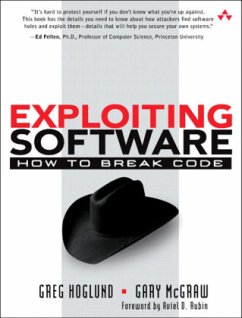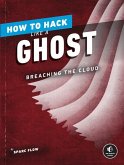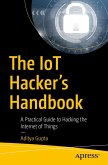Get a leg up on black-hat hackers--learn how they work and how to improve your softwares' defenses.
Using attack patterns, real code, and example exploits, learn techniques that are used by real malicious hackers against software.
Shows how to break code--If you want to protect your software from attack, you must first learn how real attacks are really carried out.
Written by Greg Hoglund and Gary McGraw--two pioneers and esteemed gurus in the software security industry.
**Foreword by Avi Rubin. How does software break? How do attackers make software break on purpose? Why are firewalls, intrusion detection systems, and antivirus software not keeping out the bad guys? What tools can be used to break software? This book provides the answers. This book is studded with examples of real attacks, attack patterns, tools, and techniques used by bad guys to break software. If you want to protect your software from attack, you must first learn how real attacks are really carried out. Learn about: Why software exploit will continue to be a serious problem; When network security mechanisms do not work; Attack patterns; Reverse engineering; Classic attacks against server software; Surprising attacks against client software; Techniques for crafting malicious input; The technical details of buffer overflows; and Rootkits. This information needs to be understood and digested by security professionals so that they know the magnitude of the problem and they can begin to address it properly. Today, all developers should be security-minded. The knowledge here will arm you with a real understanding of the software security problem. Product Description
Praise for Exploiting Software
"Exploiting Software highlights the most critical part of the software quality problem. As it turns out, software quality problems are a major contributing factor to computer security problems. Increasingly, companies large and small depend on software to run their businesses every day. The current approach to software quality and security taken by software companies, system integrators, and internal development organizations is like driving a car on a rainy day with worn-out tires and no air bags. In both cases, the odds are that something bad is going to happen, and there is no protection for the occupant/owner. This book will help the reader understand how to make software quality part of the design-a key change from where we are today!"
-Tony Scott
Chief Technology Officer, IS&S
General Motors Corporation
"It's about time someone wrote a book to teach the good guys what the bad guys already know. As the computer security industry matures, books like Exploiting Software have a critical role to play."
-Bruce Schneier
Chief Technology Officer
Counterpane
Author of Beyond Fear and Secrets and Lies
"Exploiting Software cuts to the heart of the computer security problem, showing why broken software presents a clear and present danger. Getting past the 'worm of the day' phenomenon requires that someone other than the bad guys understands how software is attacked. This book is a wake-up call for computer security."
-Elinor Mills Abreu
Reuters' correspondent
"Police investigators study how criminals think and act. Military strategists learn about the enemy's tactics, as well as their weapons and personnel capabilities. Similarly, information security professionals need to study their criminals and enemies, so we can tell the difference between popguns and weapons of mass destruction. This book is a significant advance in helping the 'white hats' understand how the 'black hats' operate. Through extensive examples and 'attack patterns,' this book helps the reader understand how attackers analyze software and use the results of the analysis to attack systems. Hoglund and McGraw explain not only how hackers attack servers, but also how malicious server operators can attack clients (and how each can protect themselves from the other). An excellent book for practicing security engineers, and an ideal book for an undergraduate class in software security."
-Jeremy Epstein
Director, Product Security & Performance
webMethods, Inc.
"A provocative and revealing book from two leading security experts and world class software exploiters, Exploiting Software enters the mind of the cleverest and wickedest crackers and shows you how they think. It illustrates general principles for breaking software, and provides you a whirlwind tour of techniques for finding and exploiting software vulnerabilities, along with detailed examples from real software exploits. Exploiting Software is essential reading for anyone responsible for placing software in a hostile environment-that is, everyone who writes or installs programs that run on the Internet."
-Dave Evans, Ph.D.
Associate Professor of Computer Science
University of Virginia
"The root cause for most of today's Internet hacker exploits and malicious software outbreaks are buggy software and faulty security software deployment. In Exploiting Software, Greg Hoglund and Gary McGraw help us in an interesting and provocative way to better defend ourselves against malicious hacker attacks on those software loopholes. The information in this book is an essential reference that needs to be understood, digested, and aggressively addressed by IT and information security professionals everywhere."
-Ken Cutler, CISSP, CISA
Vice President, Curriculum Development & Professional Services,
MIS Training Institute
"This book describes the threats to software in concrete, understandable, and frightening detail. It also discusses how to find these problems before the bad folks do. A valuable addition to every programmer's and security person's library!"
-Matt Bishop, Ph.D.
Professor of Computer Science
University of California at Davis
Author of Computer Security: Art and Science
"Whether we slept through software engineering classes or paid attention, those of us who build things remain responsible for achieving meaningful and measurable vulnerability reductions. If you can't afford to stop all software manufacturing to teach your engineers how to build secure software from the ground up, you should at least increase awareness in your organization by demanding that they read Exploiting Software. This book clearly demonstrates what happens to broken software in the wild."
-Ron Moritz, CISSP
Senior Vice President, Chief Security Strategist
Computer Associates
"Exploiting Software is the most up-to-date technical treatment of software security I have seen. If you worry about software and application vulnerability, Exploiting Software is a must-read. This book gets at all the timely and important issues surrounding software security in a technical, but still highly readable and engaging, way. Hoglund and McGraw have done an excellent job of picking out the major ideas in software exploit and nicely organizing them to make sense of the software security jungle."
-George Cybenko, Ph.D.
Dorothy and Walter Gramm Professor of Engineering, Dartmouth
Founding Editor-in-Chief, IEEE Security and Privacy
"This is a seductive book. It starts with a simple story, telling about hacks and cracks. It draws you in with anecdotes, but builds from there. In a few chapters you find yourself deep in the intimate details of software security. It is the rare technical book that is a readable an Backcover
Praise for Exploiting Software
"Exploiting Software highlights the most critical part of the software quality problem. As it turns out, software quality problems are a major contributing factor to computer security problems. Increasingly, companies large and small depend on software to run their businesses every day. The current approach to software quality and security taken by software companies, system integrators, and internal development organizations is like driving a car on a rainy day with worn-out tires and no air bags. In both cases, the odds are that something bad is going to happen, and there is no protection for the occupant/owner. This book will help the reader understand how to make software quality part of the design-a key change from where we are today!"
-Tony Scott
Chief Technology Officer, IS&S
General Motors Corporation
"It's about time someone wrote a book to teach the good guys what the bad guys already know. As the computer security industry matures, books like Exploiting Software have a critical role to play."
-Bruce Schneier
Chief Technology Officer
Counterpane
Author of Beyond Fear and Secrets and Lies
"Exploiting Software cuts to the heart of the computer security problem, showing why broken software presents a clear and present danger. Getting past the 'worm of the day' phenomenon requires that someone other than the bad guys understands how software is attacked. This book is a wake-up call for computer security."
-Elinor Mills Abreu
Reuters' correspondent
"Police investigators study how criminals think and act. Military strategists learn about the enemy's tactics, as well as their weapons and personnel capabilities. Similarly, information security professionals need to study their criminals and enemies, so we can tell the difference between popguns and weapons of mass destruction. This book is a significant advance in helping the 'white hats' understand how the 'black hats' operate. Through extensive examples and 'attack patterns,' this book helps the reader understand how attackers analyze software and use the results of the analysis to attack systems. Hoglund and McGraw explain not only how hackers attack servers, but also how malicious server operators can attack clients (and how each can protect themselves from the other). An excellent book for practicing security engineers, and an ideal book for an undergraduate class in software security."
-Jeremy Epstein
Director, Product Security & Performance
webMethods, Inc.
"A provocative and revealing book from two leading security experts and world class software exploiters, Exploiting Software enters the mind of the cleverest and wickedest crackers and shows you how they think. It illustrates general principles for breaking software, and provides you a whirlwind tour of techniques for finding and exploiting software vulnerabilities, along with detailed examples from real software exploits. Exploiting Software is essential reading for anyone responsible for placing software in a hostile environment-that is, everyone who writes or installs programs that run on the Internet."
-Dave Evans, Ph.D.
Associate Professor of Computer Science
University of Virginia
"The root cause for most of today's Internet hacker exploits and malicious software outbreaks are buggy software and faulty security software deployment. In Exploiting Software, Greg Hoglund and Gary McGraw help us in an interesting and provocative way to better defend ourselves against malicious hacker attacks on those software loopholes. The information in this book is an essential reference that needs to be understood, digested, and aggressively addressed by IT and information security professionals everywhere."
-Ken Cutler, CISSP, CISA
Vice President, Curriculum Development & Professional Services,
MIS Training Institute
"This book describes the threats to software in concrete, understandable, and frightening detail. It also discusses how to find these problems before the bad folks do. A valuable addition to every programmer's and security person's library!"
-Matt Bishop, Ph.D.
Professor of Computer Science
University of California at Davis
Author of Computer Security: Art and Science
"Whether we slept through software engineering classes or paid attention, those of us who build things remain responsible for achieving meaningful and measurable vulnerability reductions. If you can't afford to stop all software manufacturing to teach your engineers how to build secure software from the ground up, you should at least increase awareness in your organization by demanding that they read Exploiting Software. This book clearly demonstrates what happens to broken software in the wild."
-Ron Moritz, CISSP
Senior Vice President, Chief Security Strategist
Computer Associates
"Exploiting Software is the most up-to-date technical treatment of software security I have seen. If you worry about software and application vulnerability, Exploiting Software is a must-read. This book gets at all the timely and important issues surrounding software security in a technical, but still highly readable and engaging, way. Hoglund and McGraw have done an excellent job of picking out the major ideas in software exploit and nicely organizing them to make sense of the software security jungle."
-George Cybenko, Ph.D.
Dorothy and Walter Gramm Professor of Engineering, Dartmouth
Founding Editor-in-Chief, IEEE Security and Privacy
"This is a seductive book. It starts with a simple story, telling about hacks and cracks. It draws you in with anecdotes, but builds from there. In a few chapters you find yourself deep in the intimate details of software security. It is the rare technical book that is a readable an
Attack Patterns.
Foreword.
Preface.
What This Book Is About.
How to Use This Book.
But Isn't This Too Dangerous?
Acknowledgments.
1. Software-The Root of the Problem.
A Brief History of Software.
Bad Software Is Ubiquitous.
The Trinity of Trouble.
The Future of Software.
What Is Software Security?
Conclusion.
2. Attack Patterns.
A Taxonomy.
An Open-Systems View.
Tour of an Exploit.
Attack Patterns: Blueprints for Disaster.
An Example Exploit: Microsoft's Broken C++ Compiler.
Applying Attack Patterns.
Attack Pattern Boxes.
Conclusion.
3. Reverse Engineering and Program Understanding.
Into the House of Logic.
Should Reverse Engineering Be Illegal?
Reverse Engineering Tools and Concepts.
Methods of the Reverser.
Writing Interactive Disassembler (IDA) Plugins.
Decompiling and Disassembling Software.
Decompilation in Practice: Reversing helpctr.exe.
Automatic, Bulk Auditing for Vulnerabilities.
Writing Your Own Cracking Tools.
Building a Basic Code Coverage Tool.
Conclusion.
4. Exploiting Server Software.
The Trusted Input Problem.
The Privilege Escalation Problem.
Finding Injection Points.
Input Path Tracing.
Exploiting Trust through Configuration.
Specific Techniques and Attacks for Server Software.
Conclusion.
5. Exploiting Client Software.
Client-side Programs as Attack Targets.
In-band Signals.
Cross-site Scripting (XSS).
Clients Scripts and Malicious Code.
Content-Based Attacks.
Backwash Attacks: Leveraging Client-side Buffer.
Conclusion.
6. Crafting (Malicious) Input.
The Defender's Dilemma.
Intrusion Detection (Not).
Partition Analysis.
Tracing Code.
Reversing Parser Code.
Example: Reversing I-Planet Server 6.0 through the Front Door.
Misclassification.
Building "Equivalent Requests.
Audit Poisoning.
Conclusion.
7. Buffer Overflow.
Buffer Overflow 101.
Injection Vectors: Input Rides Again.
Buffer Overflows and Embedded Systems.
Database Buffer Overflows.
Buffer Overflows and Java?!
Content-Based Buffer Overflow.
Audit Truncation and Filters with Buffer Overflow.
Causing Overflow and Environment Variables.
The Multiple Operation Problem.
Finding Potential Buffer Overflows.
Stack Overflow.
Arithmetic Errors in Memory Management.
Format String Vulnerabilities.
Heap Overflows.
Buffer Overflows and C++.
Payloads.
Payloads on RISC Architectures.
Multiplatform Payloads.
Prolog/Epilog Code to Protect Functions.
Conclusion.
8. Rootkits.
Subversive Programs.
A Simple Windows XP Kernel Rootkit.
Call Hooking.
Trojan Executable Redirection.
Hiding Files and Directories.
Patching Binary Code.
The Hardware Virus.
Low-Level Disk Access.
Adding Network Support to a Driver.
Interrupts.
Key Logging.
Advanced Rootkit Topics.
Conclusion.
References.
Index.
Using attack patterns, real code, and example exploits, students learn techniques that are used by real malicious hackers against software. The author team show to break code
Using attack patterns, real code, and example exploits, learn techniques that are used by real malicious hackers against software.
Shows how to break code--If you want to protect your software from attack, you must first learn how real attacks are really carried out.
Written by Greg Hoglund and Gary McGraw--two pioneers and esteemed gurus in the software security industry.
**Foreword by Avi Rubin. How does software break? How do attackers make software break on purpose? Why are firewalls, intrusion detection systems, and antivirus software not keeping out the bad guys? What tools can be used to break software? This book provides the answers. This book is studded with examples of real attacks, attack patterns, tools, and techniques used by bad guys to break software. If you want to protect your software from attack, you must first learn how real attacks are really carried out. Learn about: Why software exploit will continue to be a serious problem; When network security mechanisms do not work; Attack patterns; Reverse engineering; Classic attacks against server software; Surprising attacks against client software; Techniques for crafting malicious input; The technical details of buffer overflows; and Rootkits. This information needs to be understood and digested by security professionals so that they know the magnitude of the problem and they can begin to address it properly. Today, all developers should be security-minded. The knowledge here will arm you with a real understanding of the software security problem. Product Description
Praise for Exploiting Software
"Exploiting Software highlights the most critical part of the software quality problem. As it turns out, software quality problems are a major contributing factor to computer security problems. Increasingly, companies large and small depend on software to run their businesses every day. The current approach to software quality and security taken by software companies, system integrators, and internal development organizations is like driving a car on a rainy day with worn-out tires and no air bags. In both cases, the odds are that something bad is going to happen, and there is no protection for the occupant/owner. This book will help the reader understand how to make software quality part of the design-a key change from where we are today!"
-Tony Scott
Chief Technology Officer, IS&S
General Motors Corporation
"It's about time someone wrote a book to teach the good guys what the bad guys already know. As the computer security industry matures, books like Exploiting Software have a critical role to play."
-Bruce Schneier
Chief Technology Officer
Counterpane
Author of Beyond Fear and Secrets and Lies
"Exploiting Software cuts to the heart of the computer security problem, showing why broken software presents a clear and present danger. Getting past the 'worm of the day' phenomenon requires that someone other than the bad guys understands how software is attacked. This book is a wake-up call for computer security."
-Elinor Mills Abreu
Reuters' correspondent
"Police investigators study how criminals think and act. Military strategists learn about the enemy's tactics, as well as their weapons and personnel capabilities. Similarly, information security professionals need to study their criminals and enemies, so we can tell the difference between popguns and weapons of mass destruction. This book is a significant advance in helping the 'white hats' understand how the 'black hats' operate. Through extensive examples and 'attack patterns,' this book helps the reader understand how attackers analyze software and use the results of the analysis to attack systems. Hoglund and McGraw explain not only how hackers attack servers, but also how malicious server operators can attack clients (and how each can protect themselves from the other). An excellent book for practicing security engineers, and an ideal book for an undergraduate class in software security."
-Jeremy Epstein
Director, Product Security & Performance
webMethods, Inc.
"A provocative and revealing book from two leading security experts and world class software exploiters, Exploiting Software enters the mind of the cleverest and wickedest crackers and shows you how they think. It illustrates general principles for breaking software, and provides you a whirlwind tour of techniques for finding and exploiting software vulnerabilities, along with detailed examples from real software exploits. Exploiting Software is essential reading for anyone responsible for placing software in a hostile environment-that is, everyone who writes or installs programs that run on the Internet."
-Dave Evans, Ph.D.
Associate Professor of Computer Science
University of Virginia
"The root cause for most of today's Internet hacker exploits and malicious software outbreaks are buggy software and faulty security software deployment. In Exploiting Software, Greg Hoglund and Gary McGraw help us in an interesting and provocative way to better defend ourselves against malicious hacker attacks on those software loopholes. The information in this book is an essential reference that needs to be understood, digested, and aggressively addressed by IT and information security professionals everywhere."
-Ken Cutler, CISSP, CISA
Vice President, Curriculum Development & Professional Services,
MIS Training Institute
"This book describes the threats to software in concrete, understandable, and frightening detail. It also discusses how to find these problems before the bad folks do. A valuable addition to every programmer's and security person's library!"
-Matt Bishop, Ph.D.
Professor of Computer Science
University of California at Davis
Author of Computer Security: Art and Science
"Whether we slept through software engineering classes or paid attention, those of us who build things remain responsible for achieving meaningful and measurable vulnerability reductions. If you can't afford to stop all software manufacturing to teach your engineers how to build secure software from the ground up, you should at least increase awareness in your organization by demanding that they read Exploiting Software. This book clearly demonstrates what happens to broken software in the wild."
-Ron Moritz, CISSP
Senior Vice President, Chief Security Strategist
Computer Associates
"Exploiting Software is the most up-to-date technical treatment of software security I have seen. If you worry about software and application vulnerability, Exploiting Software is a must-read. This book gets at all the timely and important issues surrounding software security in a technical, but still highly readable and engaging, way. Hoglund and McGraw have done an excellent job of picking out the major ideas in software exploit and nicely organizing them to make sense of the software security jungle."
-George Cybenko, Ph.D.
Dorothy and Walter Gramm Professor of Engineering, Dartmouth
Founding Editor-in-Chief, IEEE Security and Privacy
"This is a seductive book. It starts with a simple story, telling about hacks and cracks. It draws you in with anecdotes, but builds from there. In a few chapters you find yourself deep in the intimate details of software security. It is the rare technical book that is a readable an Backcover
Praise for Exploiting Software
"Exploiting Software highlights the most critical part of the software quality problem. As it turns out, software quality problems are a major contributing factor to computer security problems. Increasingly, companies large and small depend on software to run their businesses every day. The current approach to software quality and security taken by software companies, system integrators, and internal development organizations is like driving a car on a rainy day with worn-out tires and no air bags. In both cases, the odds are that something bad is going to happen, and there is no protection for the occupant/owner. This book will help the reader understand how to make software quality part of the design-a key change from where we are today!"
-Tony Scott
Chief Technology Officer, IS&S
General Motors Corporation
"It's about time someone wrote a book to teach the good guys what the bad guys already know. As the computer security industry matures, books like Exploiting Software have a critical role to play."
-Bruce Schneier
Chief Technology Officer
Counterpane
Author of Beyond Fear and Secrets and Lies
"Exploiting Software cuts to the heart of the computer security problem, showing why broken software presents a clear and present danger. Getting past the 'worm of the day' phenomenon requires that someone other than the bad guys understands how software is attacked. This book is a wake-up call for computer security."
-Elinor Mills Abreu
Reuters' correspondent
"Police investigators study how criminals think and act. Military strategists learn about the enemy's tactics, as well as their weapons and personnel capabilities. Similarly, information security professionals need to study their criminals and enemies, so we can tell the difference between popguns and weapons of mass destruction. This book is a significant advance in helping the 'white hats' understand how the 'black hats' operate. Through extensive examples and 'attack patterns,' this book helps the reader understand how attackers analyze software and use the results of the analysis to attack systems. Hoglund and McGraw explain not only how hackers attack servers, but also how malicious server operators can attack clients (and how each can protect themselves from the other). An excellent book for practicing security engineers, and an ideal book for an undergraduate class in software security."
-Jeremy Epstein
Director, Product Security & Performance
webMethods, Inc.
"A provocative and revealing book from two leading security experts and world class software exploiters, Exploiting Software enters the mind of the cleverest and wickedest crackers and shows you how they think. It illustrates general principles for breaking software, and provides you a whirlwind tour of techniques for finding and exploiting software vulnerabilities, along with detailed examples from real software exploits. Exploiting Software is essential reading for anyone responsible for placing software in a hostile environment-that is, everyone who writes or installs programs that run on the Internet."
-Dave Evans, Ph.D.
Associate Professor of Computer Science
University of Virginia
"The root cause for most of today's Internet hacker exploits and malicious software outbreaks are buggy software and faulty security software deployment. In Exploiting Software, Greg Hoglund and Gary McGraw help us in an interesting and provocative way to better defend ourselves against malicious hacker attacks on those software loopholes. The information in this book is an essential reference that needs to be understood, digested, and aggressively addressed by IT and information security professionals everywhere."
-Ken Cutler, CISSP, CISA
Vice President, Curriculum Development & Professional Services,
MIS Training Institute
"This book describes the threats to software in concrete, understandable, and frightening detail. It also discusses how to find these problems before the bad folks do. A valuable addition to every programmer's and security person's library!"
-Matt Bishop, Ph.D.
Professor of Computer Science
University of California at Davis
Author of Computer Security: Art and Science
"Whether we slept through software engineering classes or paid attention, those of us who build things remain responsible for achieving meaningful and measurable vulnerability reductions. If you can't afford to stop all software manufacturing to teach your engineers how to build secure software from the ground up, you should at least increase awareness in your organization by demanding that they read Exploiting Software. This book clearly demonstrates what happens to broken software in the wild."
-Ron Moritz, CISSP
Senior Vice President, Chief Security Strategist
Computer Associates
"Exploiting Software is the most up-to-date technical treatment of software security I have seen. If you worry about software and application vulnerability, Exploiting Software is a must-read. This book gets at all the timely and important issues surrounding software security in a technical, but still highly readable and engaging, way. Hoglund and McGraw have done an excellent job of picking out the major ideas in software exploit and nicely organizing them to make sense of the software security jungle."
-George Cybenko, Ph.D.
Dorothy and Walter Gramm Professor of Engineering, Dartmouth
Founding Editor-in-Chief, IEEE Security and Privacy
"This is a seductive book. It starts with a simple story, telling about hacks and cracks. It draws you in with anecdotes, but builds from there. In a few chapters you find yourself deep in the intimate details of software security. It is the rare technical book that is a readable an
Attack Patterns.
Foreword.
Preface.
What This Book Is About.
How to Use This Book.
But Isn't This Too Dangerous?
Acknowledgments.
1. Software-The Root of the Problem.
A Brief History of Software.
Bad Software Is Ubiquitous.
The Trinity of Trouble.
The Future of Software.
What Is Software Security?
Conclusion.
2. Attack Patterns.
A Taxonomy.
An Open-Systems View.
Tour of an Exploit.
Attack Patterns: Blueprints for Disaster.
An Example Exploit: Microsoft's Broken C++ Compiler.
Applying Attack Patterns.
Attack Pattern Boxes.
Conclusion.
3. Reverse Engineering and Program Understanding.
Into the House of Logic.
Should Reverse Engineering Be Illegal?
Reverse Engineering Tools and Concepts.
Methods of the Reverser.
Writing Interactive Disassembler (IDA) Plugins.
Decompiling and Disassembling Software.
Decompilation in Practice: Reversing helpctr.exe.
Automatic, Bulk Auditing for Vulnerabilities.
Writing Your Own Cracking Tools.
Building a Basic Code Coverage Tool.
Conclusion.
4. Exploiting Server Software.
The Trusted Input Problem.
The Privilege Escalation Problem.
Finding Injection Points.
Input Path Tracing.
Exploiting Trust through Configuration.
Specific Techniques and Attacks for Server Software.
Conclusion.
5. Exploiting Client Software.
Client-side Programs as Attack Targets.
In-band Signals.
Cross-site Scripting (XSS).
Clients Scripts and Malicious Code.
Content-Based Attacks.
Backwash Attacks: Leveraging Client-side Buffer.
Conclusion.
6. Crafting (Malicious) Input.
The Defender's Dilemma.
Intrusion Detection (Not).
Partition Analysis.
Tracing Code.
Reversing Parser Code.
Example: Reversing I-Planet Server 6.0 through the Front Door.
Misclassification.
Building "Equivalent Requests.
Audit Poisoning.
Conclusion.
7. Buffer Overflow.
Buffer Overflow 101.
Injection Vectors: Input Rides Again.
Buffer Overflows and Embedded Systems.
Database Buffer Overflows.
Buffer Overflows and Java?!
Content-Based Buffer Overflow.
Audit Truncation and Filters with Buffer Overflow.
Causing Overflow and Environment Variables.
The Multiple Operation Problem.
Finding Potential Buffer Overflows.
Stack Overflow.
Arithmetic Errors in Memory Management.
Format String Vulnerabilities.
Heap Overflows.
Buffer Overflows and C++.
Payloads.
Payloads on RISC Architectures.
Multiplatform Payloads.
Prolog/Epilog Code to Protect Functions.
Conclusion.
8. Rootkits.
Subversive Programs.
A Simple Windows XP Kernel Rootkit.
Call Hooking.
Trojan Executable Redirection.
Hiding Files and Directories.
Patching Binary Code.
The Hardware Virus.
Low-Level Disk Access.
Adding Network Support to a Driver.
Interrupts.
Key Logging.
Advanced Rootkit Topics.
Conclusion.
References.
Index.
Using attack patterns, real code, and example exploits, students learn techniques that are used by real malicious hackers against software. The author team show to break code








